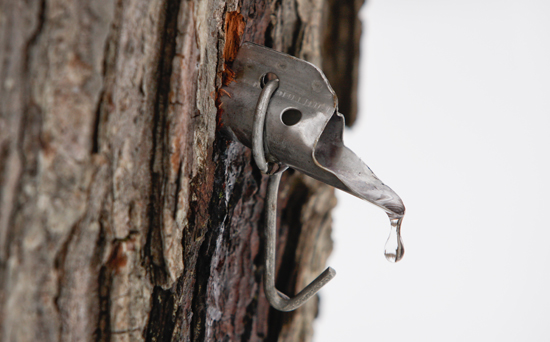 We don’t post product reviews very often here on the blog, but in this case we think we have something very new and interesting to share: maple water!
We don’t post product reviews very often here on the blog, but in this case we think we have something very new and interesting to share: maple water!
Last fall the first commercially available maple sap beverages went on the market in Canada. This spring it has been showing up on shelves in the US. Maple water was recently reported on in USA Today and Boston Magazine.
Kate Weiler, the co-founder of DRINKmaple, sent us some samples to try… and we love it! I think Kelly even likes it more than coconut water (scandalous, I know)!
Maple water is simply the sap that comes from a maple tree. This is the same stuff that would be boiled to produce maple syrup. But maple water is only faintly sweet. The sap is as colorless as spring water with almost a vanilla flavor. Depending on the particular tree and the weather, maple sap is 92 to 95% water. The remainder is made up of antioxidants, electrolytes, sugars, vitamins, and minerals. (Similarly, coconut water is about 95% water.) One of these 250 ml containers of maple water has 30 to 40% of your recommended daily manganese (a mineral important for your bones, blood, and skin).
For us Americans maple water has a smaller carbon footprint than coconut water because it is produced right here in North America. Right now maple water is available mostly in Canada and the northeast US (especially New England and New York). If you don’t live there, then you can order online at DRINKmaple. They gave us the discount code spunkymaple to share with you, which is good for 10% OFF until June 30th. (Note: drinkMAPLE sent us some free samples to try, but we do not receive payment if you make an order from them.)
I’m sure the drink will start appearing in stores in the rest of the US as time goes on. And if you have a sugar, black, silver, or red maple in your backyard, then you could even try tapping the tree for your own maple water! Visit the Tap My Trees siteand LuSa Organics blog for instructions.
Not only is maple water refreshing, but it appeals to my love of history. While maple water as a beverage has been forgotten until recently, drinking pure maple sap was common centuries ago. Early American colonists called it sugar water or maple water. Native Americans viewed pure maple sap as a sort of tonic water. In addition to using maple sap as a beverage, Native Americans also used to boil foods. (See The Maple Sugar Book and my post about the history of Native Americans’ and Maple Syrup production.)



Katie says
I have wondered if anyone would ever sell maple water. Learned to love it when lived in the northeastern part of the states.
Kelly says
Cool! Did you have your own maple trees?
Angela says
As a Mainer, it just seems weird to me to drink maple sap. I know many people don’t have gorgeous leafy maple trees in their area, but to bottle something so simple and natural and “jazz it up” to make it a hip selling point, makes me sad. Maple sap comes from old, stately maple trees, not from cute little shelf-stable packages in the grocery store. I know we need the vitamins and minerals, but… ugh. If you can’t get maple sap from the trees locally, then I don’t think you should be drinking it.